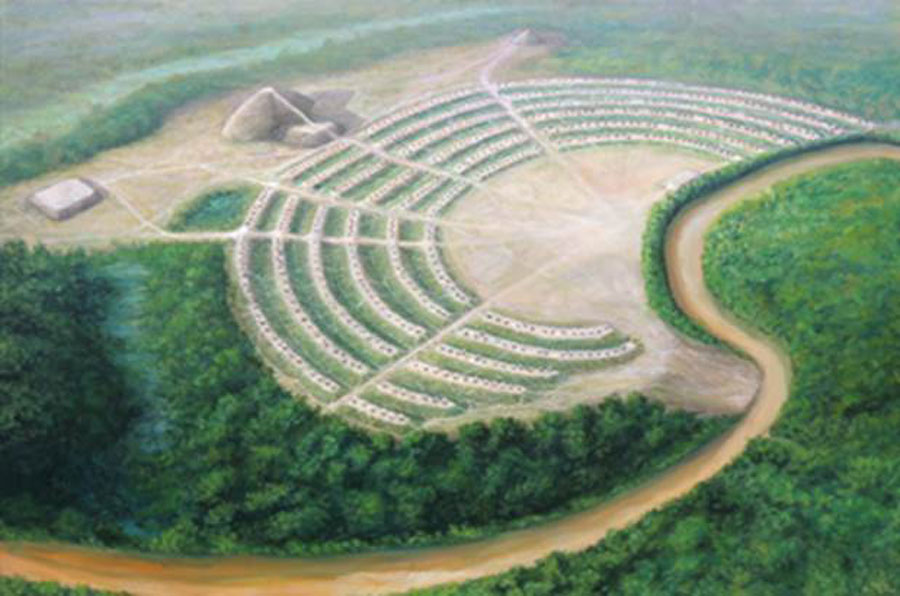Poverty Point Mound Research Helps Smash Old Paradigms
Archaeologists in North America have presented evidence of “sophisticated engineering” amongst the mound building culture. It is hoped that the new findings will help eradicate the historical hangover that still looms over many institutions and books, that Native American cultures were primitive, or “simple”, according to the researchers.
The Poverty Point archaeological site in northern Louisiana comprises a series of earthen ridges and mounds that were built by indigenous peoples in the Late Archaic period in North America (between 1700 and 1100 BC.) Now, a team of anthropologists have presented new evidence from the largest mound at this site which directly challenges traditional assumptions that North American hunter-gatherer-fishers were “simpler” than modern people.
A Gargantuan Feat of Thinking, And Then Engineering
In 1962 the federal government designated Poverty Point as a National Historic Landmark and in 2014 UNESCO appointed Poverty Point World Heritage status. The Poverty Point website says that while Stonehenge was being built in what is today England, earthen monuments were being constructed in north Louisiana. The discovery of domestic tools, human-shaped figurines and heaps of stones originating up to 800 miles (1300 km) away suggests Poverty Point was a multipurpose “residential, trade and ceremonial center,” according to the researchers.
- The Moundbuilders: North America’s Little-known Native Architects
- The Spearhead Mound: Interpretation of a Forgotten Adena Burial Site
The new findings at Poverty Point were published in Southeastern Archaeology by researchers from Washington University in St. Louis and scientists from the USDA Natural Resources Conservation Service.
Native Americans first cleared 750,000 cubic meters (nearly 981,000 cubic yards) of earth. On level platforms they constructed five earthen mounds as well as a large flat plaza and a set of six nested, semi-elliptical earthen ridges. Mound A is the largest earthen feature measuring 72-foot-tall, 710 feet long and 660 feet wide.

The illustration above shows the core features of the Poverty Point site in northern Louisiana. (T.R. Kidder / Washington University in St Louis)
To Say They Were Simple, Is Just Stupid
While many millions of words have been written in New Age books and websites pondering the purpose of this mound, lead researcher Tristram R. Kidder approached the site from a more practical angle. The researcher considered the resources required to have built the mound including the people required to clothe and feed the builders, and the actual hands-on construction team. This effort, according to the team of researchers, was “staggering.”
Native American cultures have permanently inhabited the area around the modern Poverty Point for more than 3,000 years. Traditionally, factions of archaeologists have assumed that the people who built the mounds were “simple hunters and gatherers,” according to the new paper.
However, to unite the words “hunting” and “gathering” with the word “simple,” is always the narrative of the writer who has almost lost their connection with the environment. The fact is, albeit withered, sustained outdoor survival requires serious mental prowess and hunting is never “simple,” and neither were indigenous hunters.

Geoarchaeological investigations at Poverty Point. (Washington University in St Louis)
Smashing Home New, Less Warped, Historical Paradigms
Lead researcher Professor Kidder and his team radiocarbon dated organic samples from the site and analyzed the layers of soil that comprise Mound A. The results provided “clear evidence” that the earthworks were built rapidly
Layers of sediment were carefully piled up to gradually increase the ridge height while earth works supported the expanding breadth. According to Kidder, building the enormous mounds and ridges at Poverty Point would have required “a large labor pool that was well organized and would have required leadership to execute.” Thus, the findings challenge previous beliefs about the “simpler” lifestyles of pre-modern hunters and gatherers in North America.

Each ridge is numbered. Researchers believe some of the dirt used to make the ridges came from the wet areas between them. (Washington University in St Louis)
Furthermore, the researchers identified various clay, silt and sand mixture that were developed into standardized recipes, so to enhance the longevity of the mound. This all suggests a much higher-level of social organization than previously assumed by some scientists. Kidder concludes that the site was probably an important religious site of pilgrimage for where Native Americans, “similar to Mecca.”
The report says the new findings “paint a drastically different picture of America's first civilization” whereas dated anthropology books depict the old world with an air of “simplicity.” The new paper concluded that indigenous people were “highly skilled engineers capable of building massive earthen structures, sometimes in a matter of weeks, that withstood the test of time.” Not, “just simple hunters,” as if that was ever easy.
Top image: Artist’s conception of the Poverty Point archaeological site near Epps, Louisiana at its height. Source: Herb Roe / CC BY-SA 4.0
By Ashley Cowie



















